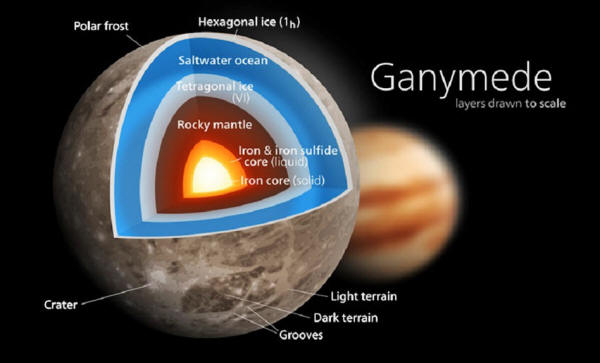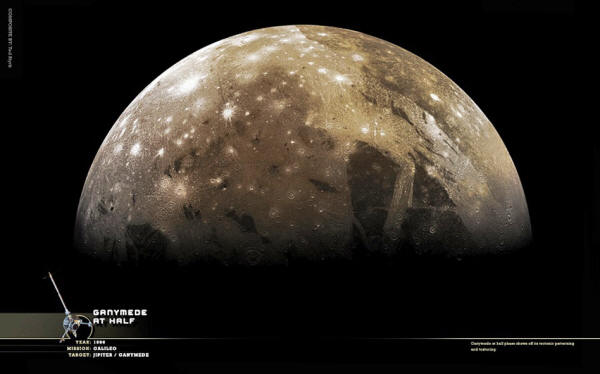|

by Ivan Petricevic
October 11,
2017
from
Ancient-Code Website

According to scientists, there are relatively good chances that
alien life is hiding
on Ganymede, one of the Jovian
moon's which has the largest ocean in the Solar System.
The
Juice mission is set to fly over the Jovian moon in order to
study with its onboard radar the deep mass of groundwater on
Ganymede. The Jovian moon is of great importance since the largest
ocean in the entire Solar System is not on Earth but on Ganymede.
If it were not for the fact that this celestial body is clearly a
satellite of the giant planet, it could perfectly pass through as a
planet itself.
In fact, with it's more than 5,200 km of diameter, Ganymede is even
larger than Mercury and only slightly smaller than Mars.
In March of 2016, the Hubble Space Telescope also made an
outstanding discovery, revealing the existence of a large saltwater
ocean in Ganymede.
And, as far as we know,
the presence of liquid water is essential when it comes to searching
for alien life in the solar system.
"This discovery
marks a significant milestone, highlighting what only Hubble can
accomplish,"
said John Grunsfeld, now retired assistant administrator of
NASA's Science Mission Directorate at NASA Headquarters.
"In its 25
years in orbit, Hubble has made many scientific discoveries in
our own solar system. A deep ocean under the icy crust of
Ganymede opens up further exciting possibilities for life beyond
Earth."
Now, experts
believe that this Jovian moon could be one of the best places where
alien life in our solar system could hide.
"We believe the
ocean of Ganymede contains more water than
on Europa," explains
Olivier Witasse, a scientist in charge of Juice (Jupiter Icy
Moon Explorer), the mission of the European Space Agency that
will explore Ganymede and Europa from 2020.
"There is six
times as much water in the oceans of Ganymede than on Earth, and
three times more than on Europa - the smallest of the four
Galilean moons
orbiting Jupiter, and the sixth-closest to the planet."
Almost at the same
time as the Juice mission fully explores Ganymede and Europa,
another NASA mission,
called Clipper, will focus on the study of
this last moon.
In this way - and
after the success of the Cassini mission to the icy moons of Saturn,
in a couple of years, we will have a complete panorama of the "oceanic moons" that surround the largest planets in our system.
Hopefully, we'll
find alien life on one of those moons.
Ganymede - A moon
which has its own magnetic field

Ganymede is by far
the largest moon in the entire solar system and the only one that
has its own magnetic field. This makes
spectacular auroras at their poles.
Because Ganymede is very close
to Jupiter, it lies within the Jovian magnetic field, so that when
Jupiter's magnetic field changes, the aurora on Ganymede also
change.
According to
initial reports, the Juice mission will bring ESA's spacecraft
relatively close to the Jovian moons, at distances between 200 and
1,000 km.
Scientists are
excited about what we could find there.
The discovery of
the huge body of water under the frozen landscape of Ganymede has
multiplied, according to scientists, our chances of finding life
without having to leave our own planetary system.
|



